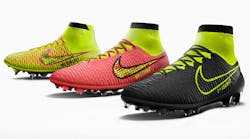"The customer can have it painted any color he wants, so long as it's black."
When he first uttered that line back in 1910 or so to describe the user options available for the new Model T, Henry Ford set in place a few defining characteristics for his products that would reign over industry for the next century.
Until then, production had been defined by craftsmanship, by uniqueness, and had been ruled by artisans. Consumers bought one-of-a-kind pieces that became status symbols for their owners and points of pride for their creators.
But after the Model T, manufacturing became defined instead by economies of scale, by price point and repeatability, by affordability and availability. All that other stuff -- uniqueness, personality, consumer choice and craftsmanship -- was left discarded on the factory floor where Henry Ford dropped it.
But now, a century later, things are starting to change.
Today's consumers want something more, something unique and tailored just for them. The market, crowded by makers, hackers, DIYers and individualists, is begging for customization, for a return of craftsmanship on a massive, industrial scale.
The world, it seems, wants something impossible: mass customization -- all the charm of artisanal production with all the advantages of mass production.
Except suddenly, in an industry saturated with new technologies and decades of agile, lean practices in place, this doesn't seem quite so impossible after all.
In fact, 100 years after Henry Ford changed the manufacturing story, we are finally on the verge of another shift -- the birth of a new era and a new epoch of manufacturing: mass customization.
Lean Customization
"We stopped counting custom designs after about 20,000," says Ryan Clark, COO of Portland-based Liberty Bottleworks. "Really, at a certain point, the fact that it's custom doesn't even matter anymore."
Clark runs a small plant, just a handful of workers in a tight shop shaping, producing and shipping up to about 70,000 aluminum drinking bottles a month.
It's a fairly high-tech little operation, though, and one just entering the real growth period of its startup course, landing more big deals with more big distributors every day, it seems. Suddenly, Clark says, his bottles are showing up on shelves next to Chinese competitors who boast a production scale wildly beyond Liberty's most generous dreams. And so far, they seem to be holding their own.
The secret of that success, says Clark, has nothing to do with scale, nor necessarily the minor pricing advantage his onshore production system can offer.
Rather, he says, it comes down to the customization factor.
Liberty consumers can customize their products online to the exact shape, size, color and graphic of their choice, all on their own, all with zero to negligible costs, all without creating so much as a hiccup on the plant floor.
"Through lean manufacturing, just-in-time inventory and digital technologies refining our business and getting production tighter and tighter, we can turn on a dime. We can do customized manufacturing simply and easily," he says. "Instead of having to make 10,000 bottles to make a profit, now I can do 100. I can do 10 with the specifications beamed straight from the art department or straight from the customer."
This, he says, is what customers demand and what, it turns out, he can provide without much effort.
Liberty isn't alone in this.
Over the last decade, this design-it-yourself business model has snuck quietly into the manufacturing market without creating much of a stir. Today, even major producers like Nike and Adidas, for example, offer specialized web portals that allow customers to design sneakers personalized to their own aesthetic and functional needs. For an added premium, you even can 3-D print a sole custom-suited for your own foot.
Automakers like Ford, Mazda and Volkswagen let consumers basically build their own cars one feature at a time, turning the driver into the engineer behind their personal dream cars. And that goes far beyond color: It's said that there are more possible configurations available for Ford's F150 pickup than there are trucks on the road, a big departure from Henry Ford's "just black" edict, to say the least.
These early experiments -- which fulfill the "customization" part of the issue, though arguably not quite the "mass" yet -- have laid the groundwork for the system that may soon become a critical element to just about every manufacturer, regardless of industry, in the next few years.
What has changed to make this niche market so important all of a sudden? The same thing that has changed everything else in the industry: technology.
3-D Printed Convergence
"We are on the verge of an explosion in terms of making mass customization -- of individualization or personalization -- a reality," argues Avi Reichental, president and CEO of additive manufacturing giant, 3D Systems.
"Inherent in the human condition is the desire to differentiate," he says. "And with the convergence of today's technologies, platforms and the Internet of Things, we are for the first time going to allow the human condition to really differentiate itself."
To Reichental, mass customization -- what he calls a "bridge back to our pre-industrial revolution heritage" -- is being enabled by five key technologies: cloud computing, mobile devices, big data, artificial intelligence and, of course, 3-D printing.
When those elements are linked together with the connected enterprise and all of its smart, wired manufacturing devices, he says, consumers have a direct line straight into the manufacturing world.
They act as designers and engineers whose orders directly alter and control the industrial process -- a system already so robust that manufacturers like Liberty Bottleworks don't even track the customizations getting beamed in.Adding "Mass"
In April, Google invited an exclusive group of coders, makers and geeks to a developers' conference for a new smartphone platform designed to bring customization to the masses.
"If you were to imagine a smartphone designed for the next 5 billion people, what would it look like?" Paul Eremenko, head of Google's Project Ara smartphone, asked the crowd.
"It would be inexpensive, it would be easy to use, it would be highly configurable to suit demographics, geographies, usage patterns and individual preferences," he said. "And it would be aesthetically and functionally custom."
That phone, he argued, will look a lot like the Ara -- a weird jigsaw puzzle of components, modules and hardware features that promise to be as customizable and upgradable as its users' imaginations and budgets allow, and as powerful as the crowdsourced developer ecosystem makes it.
The phone is basically just an endoskeleton pocked with magnetized sockets for any kind of screen, hardware or feature the consumer decides to pop in, from a high-def camera upgrade to a cigarette lighter. A glucose monitor even.
By tapping into the developer community and new 3-D printing capabilities, the project is basically bringing the already robust mass customization side of the smartphone business -- the app software development side -- to the hardware.
"What we have seen subsequent to Henry Ford's infamous ['just black'] statement is the adoption of automobiles by makers, the DIY enthusiasts, the people who are willing to hack the platform and explore new features and the integration of customization -- both functional and aesthetic customization -- into mass market products," Eremenko told the crowd.
"We want to make that trajectory real in the smartphone world as well."
A thing to keep in mind with this project is that it's coming from Google. So, this isn't conjecture on some far off fantasy for the industry. If all goes to plan, these phones could hit the market within a year, or Christmas 2015 at the latest. And with that, the world will have its first full-scale, aggressive movement to something definitely outside the bounds of simple mass production.
"This is what we've been waiting for," says 3D Systems' Reichental. "We're taking the idea of customization and turning it to scale in terms of mass-produced components and the online infrastructure to deliver gamified, customized content to scale."
"It's a powerful example of what the future of manufacturing will look like."







